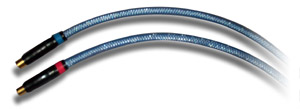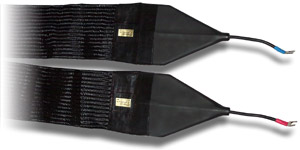![[SoundStage!]](../titles/sslogo3.gif) Home
Audio Home
Audio Equipment Review |
||||||||||||||||||||
February 2001 Magnan Signature Speaker Cables and Silver Bronze Interconnectsby Doug Schneider
Scary big. That’s my way of describing Magnan’s Signature speaker cables. When I pulled them out of the box, I immediately grabbed my tape measure -- I’d never seen something like this. Had the Canadian customs officials opened the box, I’m sure they would have thought that they had a dead python on their hands. I quickly determined that these very large speaker cables measured some four and a half inches across -- and that's per lead! There are two of these behemoth runs per side. The Silver Bronze interconnects are a little more conventional, though a little unwieldy too. Magnan uses a rather stiff, round jacket, which means the interconnect will bend from one component to another. But don’t count on making any sharp turns with these interconnects. And be thankful that Magnan considers a standard length to be four feet, which gives you just a little more play. So you may ask, why in the world would a company make cables like these? Magnan has its reasons. The skinny I skimmed around Magnan’s website and read through the company's literature. While there’s lots to digest there, the company’s main design criteria seem to be centered on minimizing skin effect. According to Magnan, the results of skin effect are "smearing of musical details, smearing together of instrumental images, flattening of the soundstage, and usually a general overbrightness." To combat this they use very thin conductors for their designs, hence the unusual configurations.
In the case of the Signature speaker cables, Magnan uses a "copper ribbon." This cable is very thin, but very wide. The conductor cannot actually be seen because it’s covered in a mesh jacket that is intended to give a more pleasing appearance than if the ribbon were exposed. Knowing it would be impossible to connect that wide a conductor to a speaker's or amplifier's binding posts, Magnan begins to taper the cable down seven inches or so before each end. There is a large triangular piece that brings the wide flat surface into a skinny wire terminated with quality parts -- spades for my review samples. You kind of just flop all this down on the floor, but Magnan says that it's best to lay the cables flat one beside the other and not one on top of the other. The Silver Bronze interconnect uses a combination of silver and bronze ribbon conductors for one lead and a "silver metalized fabric conductor" for the ground return. The ends are terminated with Neutrik connectors (my favorite). The interconnects used for this review were single ended, but they’re also available as a balanced set with XLRs. As mentioned, the Silver Bronze is a bit stiff, but it is more conventional in size and finished in an attractive light-blue jacket. The cost for entry to these Magnan cables is not for the faint of heart (at least for those who are used to spending only a few dollars on wire, not hundreds or thousands). Each will require a kilobuck -- $1000 for an 8' set of Signature speaker cables (that’s four runs) and another $1000 for a 4' pair of Silver Bronze interconnects. Sound Before I tell you what these cables do in my systems, I’ll tell you a brief bit about my beliefs. I say systems because I have multiple audio systems running in my house, and also change components in those systems over time -- so I used these cables with plenty of equipment. I believe that cables are, more or less, the icing on the cake for an audio system. For example, get your amplifier/speaker combination right and then match the cables to that. Same goes for the preamp/amplifier combo. And if you can eliminate a cable, say with an integrated amplifier (like I’ve done more than a few times this year), go with it. Minimize the signal path where you can, maximize your components by getting the best electronics and speakers you can afford, and then top it all off with the ancillary stuff.
My experimentation with the Magnan cables came mainly during my many months of reviewing components -- lots of speakers, amps, CD players and the like -- and they certainly were the icing on the cake in many cases. Before I received them, I’d heard rumors that Magnan cables were quite system dependent, but I found this not to be the case -- at least I had no troubles. While I hate to generalize about cables too much, I found that some traits kept showing up in my Magnan-wired systems, and I found these quite startling and remarkable. I also found that inserting the speaker cables or the interconnects into a system (just one and not the other) resulted in similar improvements. So if your budget doesn't allow trying both, you may want to try either the speaker cables or the interconnects to get a sense of the Magnan sound. The first thing I noticed with the Magnan cables in use was the subtle improvement in the delineation of the soundstage. I like to use minimonitors for my critical listening, and I set them up for nearfield listening, fairly far from the wall behind them. Obviously the most important aspect of imaging is in the positioning of the speakers, not the cables. With good-imaging speakers, I usually get a stage that is very precise and has starkly defined images and a fine sense of depth regardless of what cables I use. However, the Magnan cables take it a notch further in terms of body, dimensionality and specificity. Vocals tended to be more distinct and holographic in the mix. Small cues and nuances tended to be a notch more defined and cleanly rendered. Depth of stage doesn't extend any further behind, but it is just a little more cleanly rendered and I am able to hear to the back of the stage just a wee bit better. Coherency, which to my ears equates to those things that make the entire soundfield more clear and natural, is also improved. These aren’t large differences by any stretch of the imagination, but they are meaningful enough in a top-flight system. When I listen to the choral work from the soundtrack to the movie The Mission [Virgin 90567-2], there is better delineation of the voices, and the stage seems to take on more vibrancy. Until you hear these type of changes, they are difficult to appreciate. But once you hear them, it’s hard to go back. I listen to a lot of music that highlights vocalists -- Bruce Cockburn, Ani DiFranco, Bob Dylan, k.d. lang, Jewel, and others. So I tend to fixate on any changes in the way voice is rendered. Like other people, I find this easy because we’re so accustomed to hearing voices on a day-to-day basis. As a result, we know what sounds real. Of course, with cable differences, there is never any type of tonal shift (if there was, I would be deeply concerned), so any changes tend to be in terms of clarity, detail, dimensionality, and the like. While I can’t say that the Magnan cables mustered up any more detail, particularly when compared to the almost hyper-detail that is presented by Nordost’s Red Dawn Rev. II speaker cables and Quattro Fil interconnects, there certainly isn’t anything lacking here. There's no obscuring, blurring or any such thing -- these cables offer reference-level resolution. Where the real differences arise with the Magnans and vocals is in terms of warmth and bloom. The Nordost cables are visceral -- they offer lots of detail and transparency. Nothing can hide. They sound as transparent as anything. If the rest of the system is lean or clinical, that’s the way it sounds. On the other hand, the Magnans have a bit more warmth and bloom, and it’s particularly noticeable in the midrange and higher frequencies. Voices have a richer quality to them, akin to what I hear sometimes from excellent single-ended amps. They also have a sort of bell-like magic that brings just a little more fullness and weight to the highest frequencies. These again are generalizations, but they bring to light an important aspect of amp/cable/speaker matching. If the speakers or electronics you use lean more to the characteristic of the cable you are matching them with, your choice may or may not be good. I found the Magnan cables to be an ideal match to a lot of the speakers in my room -- PSB, JMlab, Cliffhanger, and even the ultra-inexpensive but extremely impressive Axiom M3Ti . They worked well with a lot of the electronics too -- Blue Circle, Resolution Audio, Audio Aero, Redgum and Vecteur. And like I said before, if you can simplify your signal path, you can sometimes improve performance and save money. For example, Redgum and Vecteur offer outstanding integrated amps that obviously negate the need for the preamp/amp connection. When I used the Magnan cables systems with these integrated amps, I just needed one Silver Bronze interconnect, and then the Signature speaker cables from the amp to the speakers. Conclusion I’m not only impressed but also quite surprised by the performance of the Magnan Signature speaker cables and Silver Bronze interconnects. Strengths include a subtle but impressive improvement in soundstaging and image specificity as well as top-flight retrieval of detail and coherency. There is also a richness that brings realism, particularly to vocals. To me the down side is simple: the price. I’m a cheapy and simply don’t like the idea of spending copious amounts of money on cables. However, that said, with what’s being asked for many cables today, the price of these Magnan cables is not out of line for the type of improvement you can get -- my Nirvana and Nordost wires cost about the same. I’ve had plenty of cables come through my room and many hardly made a difference at all. As a result, I stick to my Nirvana and Nordost cables as references. However, I’m adding these Magnan cables to my arsenal because they do something just a bit different from the rest. Both the interconnects and speaker cables are a bit unwieldy in their own ways, but this should not stop any prospective cable shoppers from putting them on their short list. They are reference-grade wires that compete with anything out there. My recommendation, then, is simple and applies to any cables I review: Try before you buy. Like I said, don’t match your system to your cables, but do pick cables that compliment and improve your system. And the Magnan Signature speaker cables and Silver Bronze interconnects can make a very good system sound truly great. ...Doug Schneider
|
||||||||||||||||||||
|
||||||||||||||||||||
![[SoundStage!]](../titles/sslogo3.gif) All
Contents All
ContentsCopyright © 2001 SoundStage! All Rights Reserved |

